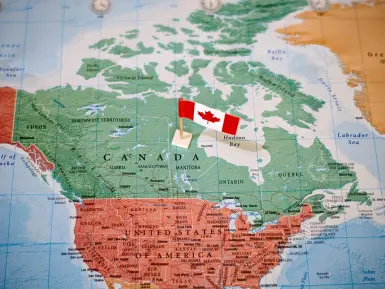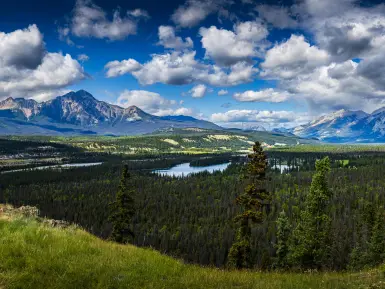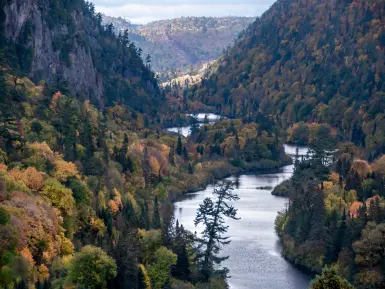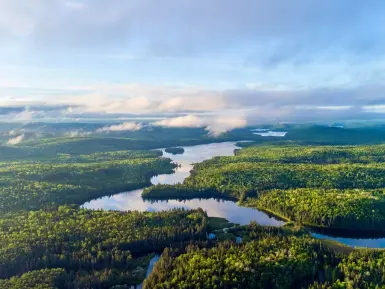At the end of September Prince William and Kate visited the Great Bear Rainforest during their royal tour of Canada. Unsurprisingly, the Duke and Duchess of Cambridge were suitably impressed.
The Great Bear Rainforest is one of the most pristine wilderness environments on Earth. In fact, this tranquil and remote region is the world’s largest intact temperate rainforest. It stretches some 250 miles along the central and north coast of British Columbia, reaching all the way towards Alaska. Characterised by lush old growth forest, teeming wildlife and meandering fjords, it is unique in the world.
Visitors heading to British Columbia on a Canadian holiday should certainly make the effort to visit this vibrant and diverse ecosystem. We’ve got some really interesting facts and figures about the rainforest to share with you. So find out what animals you could see and what you should pack if you are heading to the region.
Facts and figures about the Great Bear Rainforest

- The Great Bear Rainforest is 21-million acres in size, which is slightly bigger than Scotland
- The region can receive in excess of 2-3 metres of rainfall a year
- The forest is home to 1000 year old western red cedars and 90 metre tall Sitka spruce trees
- An article on CBC News reported that earlier this year, a landmark agreement declared 85% of the forest will be completely, and permanently, protected from logging
- The rainforest is the territory of 26 First Nations
- Some First Nations villages in the forest date back as far as 10,000 years
- The cream-coloured Kermode bear can only be found in the Great Bear Rainforest
- One of the reasons trees grow so high here is because salmon carcasses left behind after spawning release nutrients back into the rivers and streams, which fertilises the trees
- Hecate Strait in the Great Bear Sea is regarded as one of the four most treacherous bodies of water in the world, with winter storms often creating waves over 30 metres high
Animals found in the rainforest
The Great Bear Rainforest houses an abundance of wildlife from whales to wolves, though its favourite residents are its namesake bears. Here we will take you through some of the animals you could spot.
Kermode bear

The Kermode bear, also known as the spirit bear, is considered sacred by the T'simshian people and is only found in the Great Bear Rainforest.
It is hard to see one, but the best way to get a glimpse of these magical bears is to go on a bear watching holiday at the Spirit Bear Lodge.
According to scientists, this white coloured bear is a genetic variation of the black bear that roams throughout British Columbia.
The Spirit Bear is most commonly found on the Princess Royal Island in the Great Bear Rainforest. Experts believe there is such a high concentration of the bear here because they are geographically isolated from other black bears.
Grizzly bears

Grizzly bears are one of the largest bears on the planet, standing at around 7ft tall and can weigh over 1,000 pounds (more than 70 stone.)
Apart from its big size, one of the main differences between a grizzly bear and a black bear is the hump on a grizzly’s back, which is a mass of muscle that helps it dig.
The Kitasoo Xai’xais First Nation territory is home to an abundance of grizzly bears with its river valleys, estuaries and fjord lands offering perfect habitats for the animals.
Black bears

British Columbia is home to a quarter of all Canada’s black bears and current population estimates range from 120,000 to 160,000.
Black bears are commonly seen across the Great Bear Rainforest, but visitors to the area are most likely to see them in estuaries in the spring or spawning streams in autumn.
Whales

Incredibly, there are over 30 species of whales that roam Canada’s coastline. (You can find out more in our article, Wildlife in Canada: 11 animals you could meet)
One of the biggest draws to the rugged, dramatic coastline of the Great Bear Rainforest is its variety of whales. In the fjords and Pacific waters swim humpback whales, orcas and fin whales.
The orcas are majestic marine animals and can often be seen hunting for krill, salmon, seals, porpoises and other marine mammals in the area.

Humpbacks and fin whales are more commonly sighted, but visitors looking to see any of these incredible animals can choose from plenty of whale watching tours in the area.
Wolves

Their spine-tingling howl makes wolves legendary. In the rainforest, these beautiful but elusive animals range over large territories and travel in large packs.
Pack sizes vary, but generally there are six or seven members, although it has been known for some packs to exceed 15.
Wolves in the Great Bear Rainforest are different and unique. They are known as “sea wolves” as they can swim up to 10km between islands. Unlike other wolf populations which feed on deer and caribou, these wolves get their prey from the ocean. Salmon, fish roe, seals and even barnacles form their diet.
Other animals you could see:
- Cougars
- Sea lions
- Mountain goats
- Salmon
- Deer
- Sea Otters
What should you pack for a trip to the Great Bear Rainforest?

With so many things to do it can be difficult to know what to pack. But we’re here to help and have created a list of some essential items you will need during a visit.
Hiking boots
- With a host of walking routes you most certainly need hiking books or at least comfortable trainers that you can walk in.
Raincoat
- The weather can change in an instant, so if you are going on a tour or a hike then make sure you pack a raincoat.
Jumper or fleece
- Temperatures can range from around 18°C to just above 3°C and therefore packing a warm jumper or fleece is important. It can get chilly, especially if you are on a boat.
Walking trousers
- A pair of comfortable walking trousers are essential.
Camera
- With all the amazing wildlife living in the area you have to take a camera with you. You really can get some great snaps of the amazing wildlife.
Underwear
Toiletries
Passports and travel documents
Image Credit: Dogwood BC, Michael Roeder, Chutima Chaochaiya.
Latest Articles

How big is Canada?


03/07/2025
A question that many people ask is ‘how big is Canada’? Most people know Canada is big, but just how big is big?

Canada Advocate Q&A: Trish & Cathie's Race Across The World Adventure


01/07/2025
Join us this Canada Day as we celebrate the breathtaking beauty of Canada with Trish & Cathie, the incredible winners of Race Across the World series 3! Discover Canada through the inspiring lens of two adventurers who truly fell in love with its majestic landscapes and vibrant culture.

Sault Ste. Marie Travel Guide: Undiscovered Canada


30/06/2025
Sault Ste. Marie in Canada is one of Ontario’s premier adventure towns, known for its rugged lakes, mountains, and world-class outdoor activities.

Algonquin Park Travel Guide: Iconic Canada


25/06/2025
Algonquin Provincial Park is one of Canada’s most spectacular wilderness regions. The park, which is Ontario’s oldest and largest provincial park, is filled with rocky ridges, fragrant maples and thousands of lakes.












